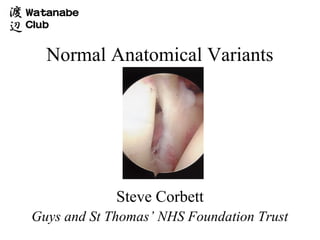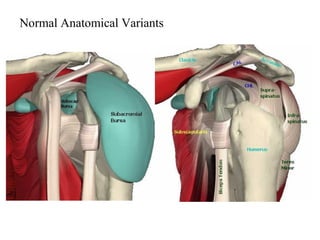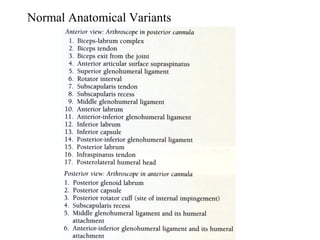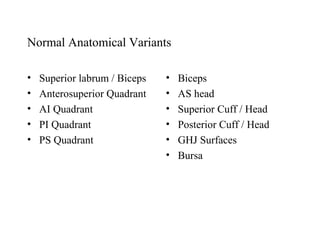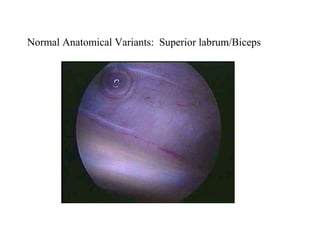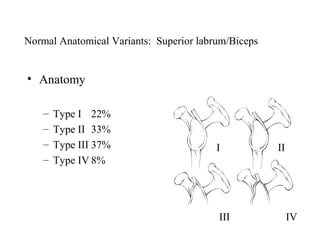Normal anatomical variants
- 1. Normal Anatomical Variants Steve Corbett Guys and St Thomasâ NHS Foundation Trust
- 5. Normal Anatomical Variants âĒ Superior labrum / Biceps âĒ Biceps âĒ Anterosuperior Quadrant âĒ AS head âĒ AI Quadrant âĒ Superior Cuff / Head âĒ PI Quadrant âĒ Posterior Cuff / Head âĒ PS Quadrant âĒ GHJ Surfaces âĒ Bursa
- 6. Normal Anatomical Variants: Superior labrum/Biceps
- 7. Normal Anatomical Variants: Superior labrum/Biceps
- 8. Normal Anatomical Variants: Superior labrum/Biceps âĒ 15% loosely attached meniscal type labrum âĒ 1-5mm width
- 9. Normal Anatomical Variants: Superior labrum/Biceps
- 11. Normal Anatomical Variants: Superior labrum/Biceps âĒ Anatomy â Type I 22% â Type II 33% â Type III 37% I II â Type IV 8% III IV
- 12. Normal Anatomical Variants: Superior labrum/Biceps âĒ Vincula Biceps âĒ Bifid Biceps â Small strands of â 1 part attached to cable mesentry â 2nd part attached to â Pass from biceps to tubercle surrounding capsule âĒ Complete absence
- 13. Normal Anatomical Variants: Superior labrum âĒ 80% firmly attached âĒ 14-60% sublabral foramen (Detrisac and Johnson 20% anatomic dissections) âĒ 6% Burford Complex
- 14. Normal Anatomical Variants: Superior labrum âĒ 80% firmly attached âĒ 14-60% sublabral foramen (Detrisac and Johnson 20% anatomic dissections) âĒ 6% Burford Complex
- 15. Normal Anatomical Variants: Superior labrum âĒ 80% firmly attached âĒ 14-60% sublabral foramen (Detrisac and Johnson 20% anatomic dissections) âĒ 6% Burford Complex
- 16. Normal Anatomical Variants: Superior labrum âĒ 80% firmly attached âĒ 14-60% sublabral foramen (Detrisac and Johnson 20% anatomic dissections) âĒ 6% Burford Complex
- 17. Normal Anatomical Variants: Superior labrum âĒ 6% Burford Complex â Cord like MGHL â No labral tissue ant/sup glenoid â Surfaces smooth
- 18. Normal Anatomical Variants: Superior labrum âĒ 6% Burford Complex â Cord like MGHL â No labral tissue ant/sup glenoid â Surfaces smooth
- 19. Normal Anatomical Variants: Superior labrum âĒ 6% Burford Complex â Cord like MGHL â No labral tissue ant/sup glenoid â Surfaces smooth
- 20. Normal Anatomical Variants: Superior labrum âĒ Divides sup. 2/5 and inf. 3/5. âĒ Variable in depth
- 21. Normal Anatomical Variants: Subscapularis / SGHL âĒ Leading edge may be split or bifid âĒ 3% âĒ SGHL present in nearly 100%, Occassionally frayed
- 22. Normal Anatomical Variants: MGHL âĒ Most variable of all ligaments â Variable origin â 70% folded thickening crossing subscapularis at 45š â 20% cord like â 10% thin veil or absent
- 23. Normal Anatomical Variants: MGHL âĒ Most variable of all ligaments â Variable origin â 70% folded thickening crossing subscapularis at 45š â 20% cord like â 10% thin veil or absent
- 24. Normal Anatomical Variants: MGHL âĒ Most variable of all ligaments â Variable origin â 70% folded thickening crossing subscapularis at 45š â 20% cord like â 10% thin veil or absent
- 26. Normal Anatomical Variants: Anterior Inferior Labrum âĒ 95% smooth attachment âĒ 5% meniscoid â Probe can be inserted but labrum not detached
- 27. Normal Anatomical Variants: Anterior Inferior Labrum âĒ 95% smooth attachment âĒ 5% meniscoid â Probe can be inserted but labrum not detached
- 28. Normal Anatomical Variants: IGHL âĒ aIGHL â Variable attachment to labrum â Distinct superior band not always present (Defined by Turkel et al) â May hypertrophy when MGHL absent
- 29. Normal Anatomical Variants: Inferior capsular recess âĒ Normally smooth âĒ Delicate synovial covering âĒ Small fenestrations âĒ Post. Sup. Band pIGHL not always well visualised (Schwartz et al)
- 30. Normal Anatomical Variants: Bare area âĒ Bare area â 2-3 mm â 2-3 cm â Frequent indentations, deep holes â Size varies with age (De Palma)
- 31. Normal Anatomical Variants: Bare area âĒ Must distinguish from Hill Sachs
- 32. Normal Anatomical Variants: Superior cuff âĒ Layer of capsule and synovium âĒ Rotator cable
- 33. Normal Anatomical Variants: Posterosuperior cuff âĒ May have fenestrations in superficial layers
- 34. Normal Anatomical Variants: Posterior labrum / Capsule âĒ 95% firmly attached âĒ 5% meniscoid, firmly attached at periphery
- 35. Normal Anatomical Variants: Posterior labrum / Capsule âĒ Normal to have a deep cleft in capsule posterior to labrum
- 36. Thank you

